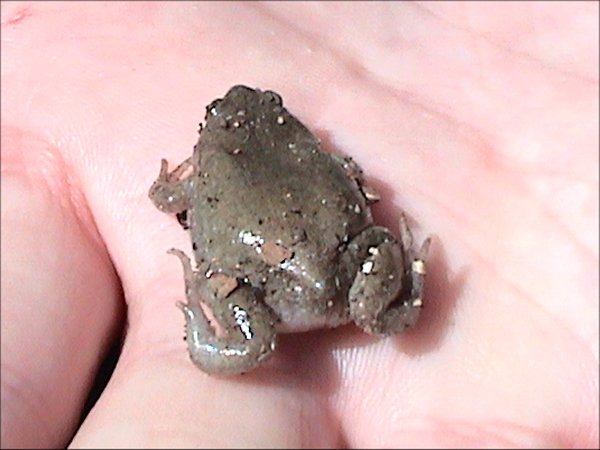- Gastrophryne olivacea
Taxobox
name = Great Plains Narrowmouth Toad
status = LC | status_system = IUCN3.1
trend = stable

image_caption = Great Plains Narrowmouth Toad
"Gastrophryne olivacea"
regnum =Animal ia
phylum = Chordata
classis =Amphibia
ordo =Anura
subordo =Neobatrachia
familia =Microhylidae
subfamilia =Microhylinae
genus = "Gastrophryne "
species = "G. olivacea"
binomial = "Gastrophryne olivacea"
binomial_authority = Hallowell, 1856
synonyms = "Engystoma olivaceum"The Great Plains Narrowmouth Toad ("Gastrophryne olivacea") is a
species of microhylidfrog . They are found throughout much of the south centralUnited States from the state ofNebraska south throughTexas , and into northernMexico . Though not a truetoad , they are often referred to as toads, because they are terrestrial.Description
Great plains narrowmouth toads are a small (1.5 inches), flat-bodied species, with a sharply pointed snout. They are typically olive
green togrey -brown in color, sometimes withblack blotching. Their underside is lighter colored. Their skin secretions can cause severe burning pain if gotten into your eyes, so be sure and wash your hands thoroughly after handling this frog.Behavior & Habitat
The great plains narrowmouth toad is found in a wide range of habitats, but most frequently in moist ground or leaf litter, and under rocks or fallen logs. They breed throughout the spring and summer months in pools of water left by rainfall. Their primary diet is
ant s.Taxonomy
"G. olivacea" was once considered a
subspecies of the eastern narrowmouth toad, "G. carolinensis", and when it was granted full species status it was divided into two separate subspecies for a time. The subspecies were eventually found to be the same.References
* Database entry includes a range map and justification for why this species is of least concern
* [http://www.zo.utexas.edu/research/txherps/frogs/gastrophryne.olivacea.html Herps of Texas: "Gastrophryne olivacea"]
* [http://research.amnh.org/herpetology/amphibia/references.php?id=14181 Amphibian Species of the World: "Gastrophryne olivacea"]
Wikimedia Foundation. 2010.
